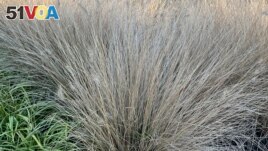25 January 2022
The end of the year can be a busy time for the gardeners who face cold winters were they live.
There is the harvest when they collect the season's crops.
Then comes the hard work of gathering fallen leaves and work to clean up flower beds and plant garlic before the ground gets too hard. Some gardeners might even have to mow the grass one last time before the snow and cold weather.

Jeff Lowenfels writes that clumps of African fountain grass can be used to replace standard lawn grass. Tall, clumping grasses are ideal for reducing the size of lawns, a worthy goal this year. (Jeff Lowenfels via AP)
But after a short winter break, many gardeners start to think in January about what comes next. They let go of what they did last year and start to plan their next moves for the new year.
While it might be snowing outside, gardeners in some northern parts of the world can be found staying warm inside. They might even look through advertisements for flowers or seeds that they can plant when the weather gets warm again.
For these gardeners, it seems that they have forgotten about the painful hands and hard work from 2021.
New Year's gardening advice
The new gardening writer for the Associated Press is Jeff Lowenfels. He shared some ideas for gardeners in 2022. He calls them New Year's Resolutions.
He asked, "Why not set a high bar for yourself?"
So, here are some of his ideas.
This year, he suggested, is a good time to stop using gas-powered garden tools. For example, if you have a lawn mower powered by gasoline fuel, consider replacing it with a manual one. If you cannot do that, Lowenfels suggests spacing out how often you use the gas-powered tools. If you used to mow two times a month, see what happens if you mow just once a month.
His next idea is to plant things in your garden that help your neighbors more than yourself. For example, Lowenfels said you can plant things in your garden that help bees, butterflies and birds. Not everything you plant has to be something you can eat or something that is pretty.
Lowenfels also noted that there are so many gardeners that people can plant food, harvest it, and donate it to local organizations. Those groups can then give it to people who do not have enough food to eat. Plant a row of plants for the hungry, he said.
One way to reduce the amount of grass you need to cut each week is to grow different plants on your land instead of grass. For example, he suggests joining the "less lawn" movement, which includes planting tall grasses that grow together as a way of taking up space. They are easy to take care of and make your lawn smaller.
Another way to reduce the size of your lawn is to make outdoor space for social gatherings. Many people want to spend less time indoors because of the COVID-19 pandemic. So, Lowenfels asked, why not make your yard a large gathering area?
Add a place where you can safely make a fire or put up a structure that can keep you out of the sun or rain. If you can, he said, extend your wireless internet connection so you can listen to gardening podcasts while you are working in the yard.
If you are thinking about all of that, Lowenfels said, you may be ready for 2022. This year's gardening season has already begun, he reminded readers.
I'm Dan Friedell.
Jeff Lowenfels wrote this story for the Associated Press. Dan Friedell adapted it for VOA Learning English.
What is your gardening New Year's Resolution? Write to us in the Comments Section and visit 51VOA.COM.
_________________________________________________________________
Words in This Story
mow – v. to cut (something, such as grass) with a machine or a blade
set a high/low bar – v. to establish a level of quality that is desired that is either high or low
manual – adj. operated by using a person's hands, not using a machine